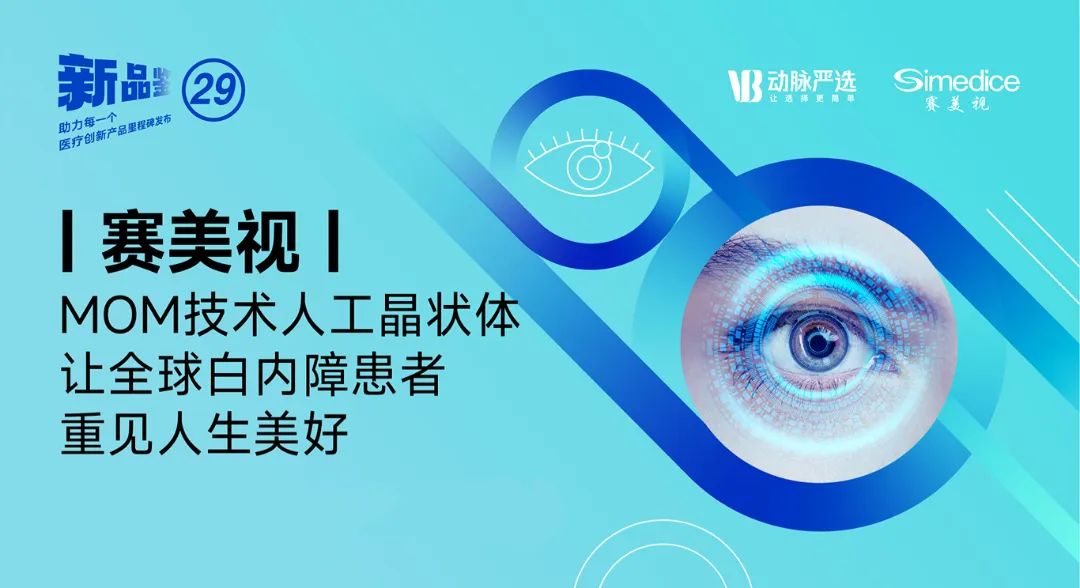[Live review] Professor Wang Yong: Clinical characteristics of Simedice’s hydrophobic intraocular lens
Date:2023-10-16 Browse:2339
01 Simedice’s live broadcast review

(Scan the QR code below to watch the live broadcast replay)
On the evening of September 21st, at the live sharing meeting held by Simedice and Artery Selection, Simedice was fortunate enough to invite Professor Wang Yong, Vice President of Aier Eye Hospital Affiliated to Wuhan University. At the meeting, based on the clinical use characteristics of Simedice’s hydrophobic intraocular lens, President Wang gave a detailed interpretation of the clinical evaluation of Simedice’s monofocal aspheric intraocular lens, corneal astigmatism corrective intraocular lens, and trifocal intraocular lens.
02 Expert introduction

Wang Yong, Vice President, Aier Eye Hospital Affiliated to Wuhan University
Chief Physician, Associate Professor, Doctoral Supervisor, Vice Chairman of the Youth Committee of the Ophthalmology Branch of the Chinese Geriatrics Society, Member of the Visual Rehabilitation Committee of the Chinese Society of Rehabilitation Medicine, Vice Chairman of the Cataract Subcommittee of the Chinese Non-Geriatric Medical Association, Cataractologist of Aier Eye Hospital Group Deputy leader of the team, director of Wuhan Medical Association, Wuhan “May 1st” model worker.
Specializing in the correction of high myopia, presbyopia, astigmatism, femtosecond laser surgery, and various complex cataract surgeries.
03 Wonderful selection
Clinical evaluation of Simedice’s monofocal aspheric intraocular lens
Dean Wang: To evaluate whether an intraocular lens is good or bad, we need to look at two aspects: one is biocompatibility, and the other is optical performance. Biocompatibility is divided into uveal compatibility and capsular compatibility. Uveal compatibility refers to whether it will be easily inflamed or rejected when placed in the eye; capsular compatibility refers to whether cataracts will occur. Relapse, how do clinicians evaluate these aspects? First of all, from the perspective of intraocular lens design, the inflammatory response of hydrophilic intraocular lenses is lower than that of hydrophobic ones; the capsule compatibility of hydrophobic intraocular lenses is better than that of hydrophilic ones. Previous studies have also shown that the incidence of post-hydrophobic intraocular lenses is in About 5%, while the hydrophilicity is about 14%. Whether such a good intraocular lens can be compatible, we can see that Simedice's monofocal aspheric intraocular lens has made some innovative designs in this regard. In terms of material, it is a hydrophobic material, so the incidence of posterior malfunction is less. However, it has undergone special low-temperature plasma treatment in the production process. This treatment improves the hydrophilicity of the material surface from the microstructure, thereby improving uveal compatibility, reducing inflammatory reactions, and achieving two-in-one compatibility. In terms of optical performance, our evaluation is divided into haze and sparkle. Hydrophobic IOLs are generally less likely to form turbidity, but if the casting process is not up to standard, they may form sparkles; the opposite is true for hydrophilic IOLs. In this regard, Simedice’s intraocular lens adopts a special process of monolithic injection molding to reduce the sparkle of hydrophobic intraocular lens without affecting contrast sensitivity. It can be seen that Simedice’s intraocular lens is very superior in terms of biocompatibility and light transmittance.
Clinical evaluation of Simedice’s corneal astigmatism-correcting intraocular lens
Dean Wang: Astigmatic intraocular lenses have a certain axial position and are prone to axial rotation. Rotation will lead to differences in corrected visual acuity after surgery. Different astigmatic intraocular lenses have different postoperative rotational stability. The early postoperative deviation is related to the insufficient expansion of the astigmatic intraocular lens and the residual viscoelastic agent during the operation. The late postoperative deviation includes the design of the astigmatic intraocular lens, Material adhesion, surface finish, compression resistance of the loop and other major factors, then increasing the total length of the astigmatic intraocular lens, reducing the deployment time of the astigmatic intraocular lens, and increasing the friction of the loop will all contribute to the stability of the astigmatic intraocular lens. We can see that first of all, in the design of the contact angle of the Simedice’s astigmatism intraocular lens, it adopts a large contact angle of 47° to optimize the c-shaped loop design, which is larger than the 40°-45° of other intraocular lenses. Such a contact angle can further increase the The larger the contact area with the bladder, the greater the friction and the better the rotational stability. In addition, the power range of the Simedice’s astigmatism intraocular lens is very wide, and the astigmatism has a correction range from 50° to 500°; secondly, the intraocular lens will shrink in the capsular bag for a long time. When the shrinkage force is uneven, the lens will Rotation may occur. Through in vitro compression force testing, we found that the improved rounded design of the C-loop connection of Simedice can make the compression force applicable to bags of various sizes. When the size of the bag increases or decreases, it will It has appropriate supporting force and reduced compression force attenuation. It can be seen that the material and mechanical structure of the Simedice’s intraocular lens are stable and the memory and resilience are good. Third, the traditional hydrophilic intraocular lens is easy to expand during implantation, while the hydrophobic intraocular lens is easy to expand. The crystal unfolds slowly and is not easy to attach directly. Rotation may also occur at this time. The Simedice’s astigmatism intraocular lens uses improved hydrophobic material, which has better performance than traditional hydrophobic intraocular lenses and is easier to deploy and quickly put into place.
Clinical evaluation of Simedice’s trifocal intraocular lens
Dean Wang: We are currently conducting clinical research on the trifocal intraocular lens. Its additional powers are 3.2 and 1.6, which are relatively close to Zeiss’s 3.33 and 1.66, and the mid- and near-distance lenses are also 40 to 80 centimeters. This intraocular lens is a trifocal intraocular lens that combines refraction and diffraction. It has 16 diffraction rings in the middle and an effective optical aperture of 6.0 mm. This is also a very interesting design feature of the Simedice’s trifocal intraocular lens. In addition, the light energy distribution design of the trifocal intraocular lens is 50% for distance vision, 20% for intermediate vision, and 30% for near vision, which can meet the needs of patients with and without cataracts for far, intermediate, and near vision; according to the patient's vision requirements demand, the light is distributed asymmetrically, and is distributed in a ratio of 20:30 between mid-focus and near-focus, which further improves the demand for near vision; under a large aperture, its light can be distributed more towards the far focus, adapting to the distance under large apertures. Distance vision needs; at the same time, Simedice’s trifocal intraocular lens provides 0μm, -0.1μm, -0.2μm spherical aberration design to compensate for the positive spherical aberration produced by the lens itself and the cornea, achieving better visual quality. Compared with the control group in clinical studies, we can see that the functional distribution of the Simedice’s trifocal intraocular lens is very ideal.
Summary of Simedice’s Hydrophobic Intraocular Lens
Dean Wang: As a national key research and development project material, the Simedice’s hydrophobic intraocular lens series is, firstly, moderately soft and hard, suitable for expansion, smooth injection, and easy to operate; secondly, as a hydrophobic material, Simedice’s intraocular lens has also been hydrophilic modified, so its loops do not adhere to the optical surface and have better biocompatibility; the third largest contact angle design can make the posterior capsule fit well, the postoperative position is stable, and the axial rotation is low; the fourth Simedice's patented mold injection technology can ensure that after lens implantation, there will be less hindrance, less sparkle, good postoperative vision correction, and high visual clarity for patients after surgery. In addition, the innovative large contact angle modified C-loop design of the Simedice’s intraocular lens can increase the friction between the intraocular lens and the capsular bag, further improving rotational stability; the improved loop has strong compression resistance and improves the long-term stability of the intraocular lens.
